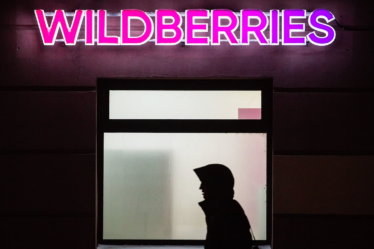
The future of fashion is menswear.
While the men’s department at most brands and retailers is still a fraction of the size of women’s, business is booming as shoppers trade in their skinny jeans and fitted suits for wide-legged trousers, loose-fitting tees and casual attire suitable for both work and social occasions.
At London-based luxury retailer MatchesFashion, sales of men’s clothing are up 40 percent compared to the same period last year, while men’s footwear is up 50 percent, said the company’s head of menswear Damien Paul. Other retailers, too, are noting the category’s growth opportunity.
“The boom in menswear is quite unprecedented,” said Michael Kliger, chief executive of German luxury e-commerce retailer Mytheresa, which launched its menswear offering in 2020.
Euromonitor projects the category will grow faster than womenswear over the next four years, expanding to $547.9 billion by 2026, at an average annual growth rate of 5.8 percent, compared to 5.3 percent for womenswear.
Brands are betting this is a long-term shift. The Outnet launched its menswear offering in March to capitalise on the market’s “huge potential” after seeing demand from existing customers and brand partners, according to Emma Mortimer, the company’s managing director. J.Crew will relaunch its revamped menswear category under Noah designer Brendon Babenzien in the fall.
Luxury players are also investing in the space. Louis Vuitton will open a dedicated men’s store in Beverly Hills on July 14. Italian luxury tailoring brand Zegna is pursuing a sportier and more immersive menswear approach as suiting fades in relevance. So far, this shift has helped the brand grow revenues by 27 percent to €1.29 billion ($1.31 billion) in 2021. Labels like Burberry, Gucci and Dior have signed new sports star ambassadors to capitalise on growing interest from new audiences of men. Last week, for example, 19-year-old football star Eduardo Camavinga walked the runway in Demna’s Balenciaga couture show in Paris.
The menswear boom is driven largely by a fashion reset. The casualisation of menswear had begun far prior to the pandemic, but the new work-from-home lifestyle that emerged in 2020 has cemented new silhouettes that prioritise comfort.
Gender fluidity plays another role in the category’s revival, widening the scope and appeal of men’s clothing.
Streetwear, meanwhile, has lost steam. Hoodies, tracksuits and sneakers are no longer hit items at Mytheresa, according to Kliger, with casual jackets, shirting and loafers now driving sales.
Skinny jeans, formal suits and figure-hugging tops are also out, as men now favour wider-legged cropped trousers, cargo pants and oversized shirts — clothing they can wear on most life occasions, said Chris Black, a menswear and culture specialist who consults for brands like Thom Browne, New Balance and Stüssy through his agency, Done to Death Projects.
“Coming out of the pandemic, it’s clear that we’re headed for the death of streetwear — men now prefer casual suits or shoes with hard soles over sneakers,” Black said.
A New Fashion Cycle
Tejumola Butler Adenuga, a 27-year-old London-based artist, has been shopping frequently this spring and summer in a bid to refresh his wardrobe. In recent months, he has purchased an open-neck linen shirt from Maison Margiela, a pair of Bottega Veneta boots and a Prada nylon shoulder bag, among other items.
“For me, when I shop these days, comfort is key — the era of tight-fitting clothes is over for men,” Adenuga said. Since the pandemic, he added, “I’m willing to pay more for clothes that fit right and feel better.” In May, he purchased loose, open hemmed trousers from Bottega Veneta, taking advantage of the brand’s alteration services to get the perfect fit.
To cater for men like Adenuga who are now looking for bespoke product alterations, UK-based luxury retail chain Flannels has invested in a more personalised menswear shopping experience, said David Epstein, managing director of parent company Frasers Group. At the retailer’s newly opened flagship store in Liverpool, consumers can get their clothing made to measure at a tailoring hub on the menswear floor, with a chance to select fabrics or styles from over 10 participating brands.
Meanwhile, brands like Zegna have scaled back their bread-and-butter suiting staples, including ties, instead promoting casual pieces like sports coats and knitwear. New luxury cult brands like Aimé Leon Dore have captured the zeitgeist of contemporary menswear, capitalising on trends like “blokecore” — a viral subculture that celebrates the style of middle-aged men, like wide-legged jeans, quilted cardigans, polo shirts and bucket hats. The blokecore hashtag has over 27 million views on TikTok.
Hot Growth Categories
Accessories have also become a growth area in menswear over the last year, retailers said. At Mytheresa, leather accessories and hit items like Prada’s crossbody nylon bags are driving sales in the category, Kliger said.
Flannels, too, has seen increased demand for bags and sunglasses. Men’s accessories sales are up 35 per cent year-to-date, according to managing director Epstein. Meanwhile, Mr Porter has doubled its fine jewellery brand offering in the last year thanks to increased demand, the company said, and Matches Fashion also noted a rise in spending on watches and fine jewellery this year as well.
What’s happening now in menswear mirrors the evolution that womenswear is already seeing, according to Karla Martin, managing director of Deloitte. Lower barriers to entry and the proliferation of social media created opportunities for new brands to launch, “giving choices for men across all categories,” she said.
New Ways to Access Menswear
How men engage with fashion overall has deepened, according to Black.
“Before, it was a case of learning about clothes or brands through your girlfriend or partner,” he said, noting that it has become common in recent years “for men to spend time and money on clothing, to talk about it with friends.”
New cultural channels are introducing people to menswear for the first time. Podcasts like Throwing Fits, Instagram accounts such as NCL Gallery, Hidden and JJJJound, as well as subreddits and Discord channels have been pivotal in enabling menswear to reach new audiences.
These online pages represent cultural hubs of exchange for menswear fans, in what was previously an environment reserved for fashion insiders. Regular menswear lovers like Adenuga browse their content for styling inspiration, brand discovery and information on upcoming releases.
“So much of this menswear boom is personality-driven, either by influencers or aspirational figures like athletes who men look up to,” said Chris Black.



